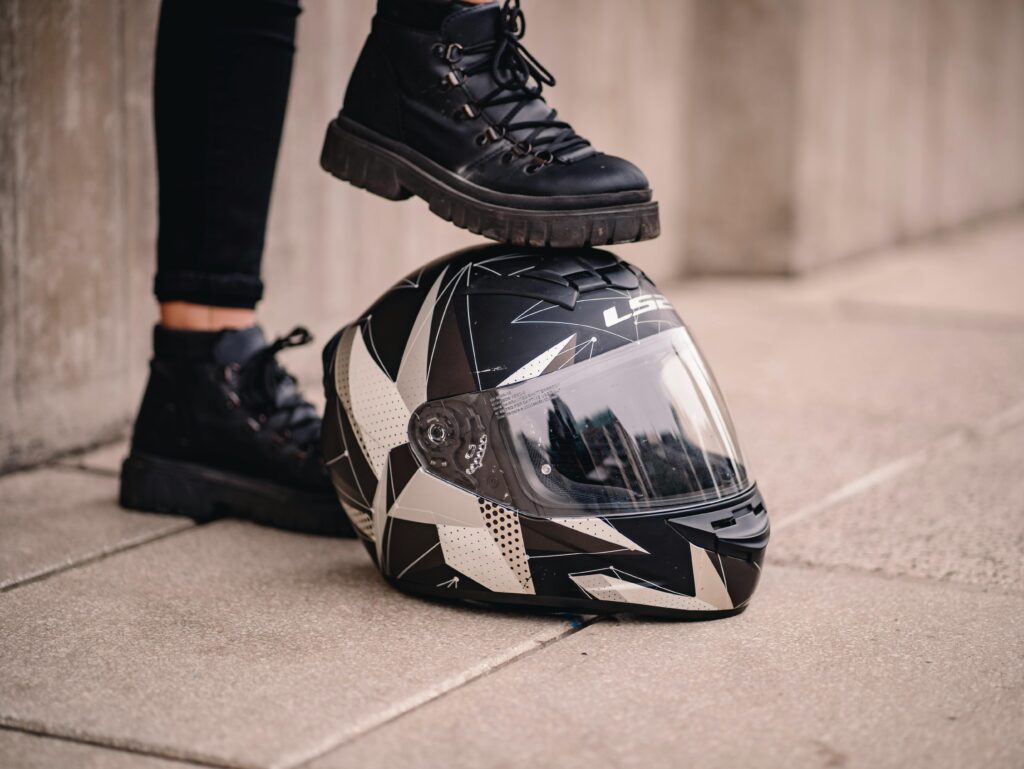Have you ever felt unsure about how to clean your motorcycle helmet properly?
It’s not just you. Many new and even experienced riders feel overwhelmed when it comes to helmet care. In fact, a 2023 rider survey by RevZilla found that over 60% of motorcyclists clean their helmet less than once every three months, despite frequent use. Neglecting basic cleaning can lead to foggy visors, unpleasant odors, and even bacterial buildup in the liner.
The good news is, it’s not nearly as hard—or as technical—as it looks.
Interestingly, my husband and I are very good at cleaning helmets. When we first met, my husband and I lived in a remote mining town called Kalgoorlie, in Western Australia. Due to the large, open-pit gold mine, as well as the close proximity to the desert, Kalgoorlie would be constantly covered in red dust. As a result, we cleaned every nook and cranny on the regular, so as to avoid our helmets being filled with red dust.
By following these simple, step-by-step guidelines, you’ll therefore learn how to clean your motorcycle helmet safely, effectively, and without damaging it—inside and out.
Let’s get started and give your helmet the fresh start it deserves.


How to Clean Your Motorcycle Helmet: Why It Matters
Although your motorcycle helmet is arguably your most critical piece of protective gear, it is also most often neglected when it comes to maintenance. Cleaning your helmet isn’t just about keeping it looking sharp; it’s about preserving its integrity, hygiene, and effectiveness.
As a result of poor helmet hygiene, dirt, sweat, and road grime can slowly break down the internal padding and fog up your visor. In addition to being uncomfortable, this build-up can even reduce the safety of your helmet over time. Worse, bacteria and fungi can develop in a dirty liner, leading to acne, skin irritation, or worse—smelly morning commutes.
Keeping your helmet clean ensures better visibility, longer-lasting materials, and a healthier riding experience. Whether you’re a seasoned rider or just starting out, understanding how to clean your motorcycle helmet should be a core part of your gear care routine.
If you would like a broader understanding of motorcycle safety gear care, check out our motorcycle gear guide for beginners.
Pro-Tip: Cleanliness of your helmet matters incredibly, but safety is more important. If you have an accident with contact on your helmet, consider the need to replace it. No matter how clean the helmet is, if it isn’t structurally intact, it won’t perform the function it needs to.

What You’ll Need to Clean a Motorcycle Helmet
Now that you know why motorcycle helmet hygiene is so important, let’s consider the right tools for a thorough, yet safe cleaning process.
These essentials include:
- Microfibre cloths — Soft and non-abrasive to prevent scratches on the shell and visor.
- pH-neutral soap or baby shampoo — Gentle cleaners that won’t damage the helmet’s materials.
- Soft detailing brushes or toothbrushes — To reach vents, seams, and crevices.
- Cotton swabs — For small, hard-to-reach areas.
- A basin or bowl with warm water — For soaking removable parts.
- Helmet stand or clean towel — To air-dry components safely without warping.
Moreover, specialised helmet cleaning kits can also be convenient. They often include helmet-safe cleaning sprays and microfibre cloths, though they’re not always necessary if you have the essentials above.
Similarly, aim to avoid harsh chemicals such as bleach, ammonia, or alcohol-based cleaners, as these can degrade protective coatings and adhesives.
Thinking of holidaying? Find out what lightweight touring helmet is best for your upcoming trip.
Pro Tip: Always buy products that are suited for motorcycle use. You may find something cheap on Amazon which looks ok, but may also dissolve the plastic of the helmet. With such an expensive piece of safety gear, I wouldn’t risk cutting corners to save a few dollars.

Optional Tools and Accessories to Level Up Your Helmet Care
While basic supplies suffice for most riders, certain tools can make cleaning faster, more effective, and thorough—especially if you ride often or in tough conditions. These accessories aren’t essential but can streamline care and help maintain your helmet’s performance.
- Compressed Air: A can or small compressor clears dust, debris, and insects from vents and tight spots without adding moisture, reducing mould risk.
- Helmet Dryers: Ideal for humid or rainy climates, these gently circulate air to dry liners without heat damage. Some models also neutralise odours.
- Anti-Fog Treatments: Sprays or wipes prevent visor fogging for better visibility in cold or humid weather. Always test first to protect coatings.
- Helmet Bags and Storage Mounts: Proper storage prevents damage and dust buildup. Padded bags are great for travel; wall mounts keep helmets organised at home.
- Soft Detailing Brushes: Soft-bristled brushes or old toothbrushes clean textured surfaces and trim without scratching.
For serious riders or motorcycle commuters, investing in these optional tools can make routine care easier, faster, and more protective.
If you’re looking to get started on your upcoming holiday gear, have a look at our guide on the best motorcycle helmets for travel.

Step-by-Step Guide: How to Clean Your Motorcycle Helmet
Here’s a comprehensive, stepwise approach to cleaning your helmet thoroughly and safely:
- Remove Electronics and Disassemble Parts: Remove any Bluetooth or intercom devices per instructions. Detach removable parts like the visor, liners, and cheek pads. Check your manual to avoid damage.
- Clean Interior Liners and Cheek Pads: Hand wash liners and pads in warm water with mild soap. Rinse well, avoid wringing, and air dry flat away from heat.
- Clean the Outer Shell: Wipe the shell with a microfibre cloth and pH-neutral soapy water. For stubborn dirt, let a warm damp cloth soften it before wiping. Avoid harsh chemicals.
- Clean and Polish the Visor/Face Shield: Remove visor and gently clean with microfiber cloth and mild soap. Rinse and dry with a soft cloth. Avoid paper towels to prevent scratches.
- Detail the Vents and Air Channels: Use a soft brush or cotton swabs to remove dust and bugs. Blow out tight spots with compressed air without adding moisture.
- Reassemble and Inspect for Wear and Damage: After drying, reassemble carefully. Check fasteners, hinges, and straps for wear, replacing damaged parts to maintain safety.
Regularly following these steps will keep your motorcycle helmet clean, comfortable, and safe for every ride.
For more detailed gear cleaning and maintenance tips, read our guide on how to clean your motorcycle gear for beginners.

How Often Should You Clean Your Motorcycle Helmet?
Cleaning frequency depends on several factors:
- Riding conditions: Dusty, wet, or sweaty rides require more frequent cleaning.
- Sweat level: Heavier sweating during hot weather calls for more interior cleaning.
- Weather: Rain and mud exposure mean more exterior washing.
A good rule of thumb:
- Weekly or biweekly wipe-down of the shell and visor if you ride often.
- Monthly or bimonthly full interior cleaning including liners and pads.
If you notice unpleasant odors, foggy visors, or liner wear, it’s time to clean or replace components. Regular maintenance prevents buildup that reduces comfort and safety.
Your helmet isn’t the only thing that needs cleaning. Check out our guide on hair care for motorcycle riders to ensure the inside of your helmet stays cleaner for longer.

Common Mistakes to Avoid When Cleaning Your Helmet
Even well-intentioned care can harm your helmet if done incorrectly. Avoid these common pitfalls:
- Using abrasive cloths or harsh solvents: Paper towels, rough sponges, or cleaners like bleach and ammonia can damage your helmet’s finish, weaken adhesives, and strip protective coatings. Stick to microfibre cloths and pH-neutral soap for safe cleaning.
- Submerging the entire helmet in water: Fully soaking your helmet can let moisture into the EPS liner or electronics, compromising protection. Clean components individually and avoid water saturation.
- Drying in direct sunlight or with excessive heat: Heat from the sun or dryers can warp plastic, degrade foam, and damage adhesives. Always air dry your helmet in a cool, shaded area.
- Over-tightening or damaging liner fasteners: Applying too much force when reassembling can snap clips or strip threads. Use gentle pressure and follow your helmet’s manual for reassembly.
- Neglecting post-cleaning inspection: Skipping a quick check can mean riding with loose straps or worn parts. Always inspect your helmet for fit, function, and signs of wear before using it again.
Proper technique protects your investment and ensures the helmet continues to perform optimally.
Discomfort and maintenance hassles can also find you on the road. To avoid them, explore our guide to the best lightweight touring helmets.

Long-Term Maintenance Tips for Helmet Longevity
Beyond cleaning, maintaining your helmet ensures it stays safe and comfortable longer:
- Perform routine spot cleaning after rides to remove sweat and dirt before buildup occurs.
- Store helmets in a cool, dry place away from direct sunlight and chemicals.
- Use a helmet bag or cover during transport to prevent scratches.
- Replace liners and cheek pads as needed when they lose shape or develop odors.
- Regularly inspect straps, fasteners, and visors for wear or damage.
Consistent care keeps your helmet looking and performing like new, extending its usable life and your riding enjoyment.
Pro Tip: Let’s be honest, I, too, don’t do all of the above. A lot of days my helmet gets thrown in the mud room after use with no further attention. This is something I need to improve on too. However, I am starting to remind myself how expensive motorcycle gear is. I could spend that money in better ways if I looked after my things. Let us make this change together!

Helmet Cleaning Essentials for Traveling and Touring Riders
When you’re on the road for days or weeks at a time, helmet hygiene can quickly fall by the wayside—but it’s just as important as at home. Sweat, dust, bugs, and rain can take a toll on your gear, especially if you’re riding through varied climates. Fortunately, with a compact kit and a bit of planning, you can maintain helmet comfort and cleanliness throughout your journey.
- Travel-size pH-neutral soap or helmet wipes: Pack a small bottle of gentle soap or opt for disposable helmet-safe cleaning wipes. They’re ideal for wiping down your visor and shell at fuel stops or at the end of a dusty ride.
- Microfibre cloths: Lightweight and reusable, microfiber cloths are essential for wiping visors and drying liners after a quick rinse. Keep a few tucked in a ziplock bag to separate clean and used ones.
- Portable helmet bag: A padded helmet bag not only protects your helmet when off the bike but can double as a storage solution for your cleaning supplies and cloths.
- Quick-dry towel or travel chamois: Great for drying liners after a rinse or cleaning bug splatter off your helmet’s outer shell without scratching it.
- Mini anti-fog spray: Especially helpful in changing weather, these compact treatments help maintain clear vision and reduce moisture buildup inside the visor.
- Vent brush or cotton swabs: Tiny but powerful—these take up no space in your kit and help clear dust and bugs from vents after long rides through rural or off-road areas.
By preparing a lightweight helmet care kit, you can keep your gear fresh and functional while touring—without taking up valuable pannier space.
For a fully prepared tour, don’t miss our expert guide on the best motorcycle luggage for touring.

FAQ: How to Clean Your Motorcycle Helmet
Q: Can I use household cleaners to clean my helmet?
No, household cleaners are not suitable. They often contain harsh chemicals like bleach or ammonia that can damage helmet materials. Always use mild, pH-neutral soap or baby shampoo.
Q: Is it safe to wash the helmet shell with water?
Yes, but never submerge the entire helmet. Use a damp cloth with mild soap to wipe the shell gently, avoiding excess water around vents and seams.
Q: How do I remove stubborn bugs from my helmet?
Soften bugs with a warm, damp cloth placed over the area for a few minutes before wiping gently with a microfibre cloth.
Q: Can I use a dryer to dry helmet liners?
No, heat can damage liners and foam. Always air dry liners flat away from direct sunlight or heaters.
Q. How often should I replace my helmet?
Most manufacturers recommend replacing your helmet every 5 years or sooner if it sustains impact or shows signs of damage.

Final Thoughts
Cleaning your motorcycle helmet doesn’t have to be complicated—but it does have to be consistent. With the right approach and a few essential tools, you can keep your gear hygienic, clear, and fully functional for the long haul. Regular maintenance not only extends your helmet’s lifespan but also protects your health and riding safety. Whether you’re commuting, touring, or hitting weekend roads, a clean helmet makes every ride more comfortable and focused.
Got any go-to cleaning tips or favourite helmet-care products? Let me know in the comments below!
For more gear advice, check out our guide to lightweight touring helmets and don’t miss our expert breakdown of how to clean all your other motorcycle gear.





